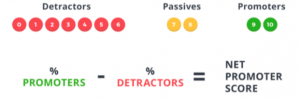The most commonly used metric is NPS.
Even though it doesn’t seem like it, the NPS metric is important to many companies. Here is a brief overview of what NPS means, how is NPS calculated, and what is a good NPS score to achieve.
What does NPS mean?
The NPS means Net Promoter Score and it’s a metric specifically developed to measure customer loyalty, judging by a customer’s likelihood to recommend a product to others.
What is NPS and why is it important?
The NPS survey is specifically centered around the question:
“How likely is it that you would recommend Company to a friend or colleague?”
Customers can then respond on a scale from 1 (very unlikely) to 10 (very likely). Those responses separate customers into three categories:![]()
How is NPS calculated?
The total NPS is calculated by subtracting the percentage of detractors from the percentage of promoters.
What is a good NPS?
Customers who answer lower than 6 are detractors, while those who respond with a 9 or higher are promoters. Customers responding 7-8 are passives.
💡 Reading recommendations
- What is a Good Net Promoter Score & What Should We be Aiming for?
- Measure Your Customer Loyalty by Combining NPS and CSAT Score
- 25 Support Emails To Generate Trust and Loyalty Resource
🎙 Podcast tip
If you want to achieve high NPS you must not only provide excellent customers service but also delight or surprise your clients (of course, in a good way!).
“The key for us is never losing some kind of human connection.”
Listen in as Marc from Koala highlights some tips & tricks on how you can perpetually delight your customers.
Conclusion
Thanks to NPS you can measure how loyal is your customer to your brand and your business. Remember, there are two “things” you should always take care of – your clients and your NPS. We are here to help you with both of them.
Follow us for more Customer Support tips!









